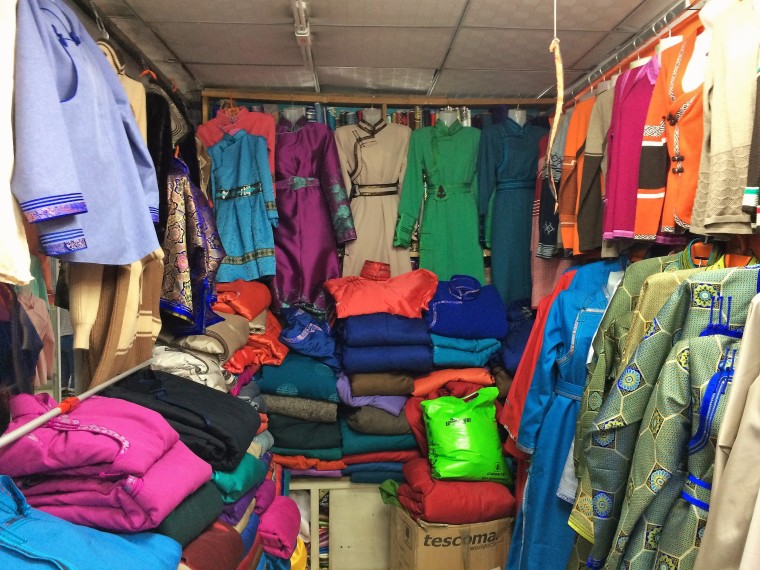If it weren’t for Chinggis Khan and his Golden Horde that took the world by surprise in creating the world’s largest empire, the world might know absolutely nothing about Mongolia. Dwarfed between two colossal sized countries, China and Russia, Mongolia has quietly endured its own ruthless past that came to an end when the Soviet Union collapsed in December 1991.
Since arriving in Mongolia in May 2016, I have encountered and participated in many Mongolian traditions and customs such as drinking milk tea, eating Mongolian food, playing shagai, partaking in the Nadaam festival, and buying and owning my own deel.
For this post, I will focus on the Mongolian deel. For centuries, Mongolians have worn deels. With a sheep- wool lining inside, deels have kept Mongolians warm during the harsh winters. Easy to put on, a deel can be pulled over and pulled at the waist using a belt and small clasps on the side. You can find deels in a variety of colors. Most notably are the colors blue, red, yellow, green, and white. Blue represents Mongolia’s blue sky. After all, Mongolia is known as the Land of the Eternal Blue Sky. Red symbolizes fire; white symbolizes milk; green symbolizes the Nine Stones; yellow is a symbol of the Dali Llama’s yellow robes.



The Buddha’s followers compiled his teachings into books – most notably, the Kangyur. In the 1650s, the Mongolian monk, Zanabazar, brought a collection of the Kangyurs into Mongolia from Tibet. Today, 10 different types of Kangyurs are safely preserved in the National Library of Mongolia. One notable copy was written with 9-precious stones: gold, silver, corral, pearl, mother of pearl, turquoise, lapis lazuli, copper, and steel. All stones were crushed into a powder and mixed with water and goat’s milk for ink.
Now in 2016, deels come in an assortment of patterns, some subtle while others can be very eye-catching. Some possess intricate details on the sleeves and collars, can have wide sleeves or thin sleeves, and more colors have been introduced such as purple and pink. Styles have also evolved from the traditional Mongolian deel to a more Chinese inspired deel.

There are many different types of deels distinguished by its cut, color, and trimming. Each ethnic group has their own type of deel. They can be long or short. They can be one piece or two piece and made from different materials. Silk from India, Japan and China are popular. Most notably are the winter and summer deels. Winter deels are thickly padded to keep out the chill.



On the second floor inside an old building in the market, I found Nachagnyam’s deel store. She has been making deels since 1992. She learned the skill from her mother. Beginning first with smaller deels for children, called a баривч (barevch), she has worked herself up to making a variety of deels for everyone. Now she works with a team of young women. When I asked how long it takes to make a deel, she said that it can take one to three days depending on the style. Nachagnyam then said that she wants to see more people wearing deels, most notably the younger population. In a much smaller deel store, Yanjmaa also believes more people should wear deels. She claims they are necessary for survival and a deel belt can keep a person’s stomach and kidney warm.



In Ulaanbaatar, it is seldom when you see a person walking down the street in a deel. Now, it is usually the herders and folk from the county side who wear a deel. With Ulaanbaatar undergoing much construction in becoming a modern city, a gulf has opened between the modern age and the traditional age: from living in gers to moving into houses and apartment buildings. From wearing deels to sporting western clothing. However, Mongolians haven’t entirely severed their ties to their country’s history. During major holidays, such as Naadam and Tsagaan Tsar, Mongolians return to their roots and pay homage by wearing deels while celebrating with friends and family.
My blog post is based on my previous knowledge from what I have read about Mongolia, what I have seen during my stay, and from what I have heard when speaking to Mongolians. This is not intended to be a thoroughly researched article but something that I wanted to do due to my own fascination and interest.




Fascinating article. I’ve wanted to go to Mongolia for a long time. Thanks for sharing your experiences.
LikeLiked by 1 person
Thanks for reading! I hope you get to one day.
LikeLiked by 1 person
Me too! Thanks for sharing your experiences 🙂
LikeLike
Hi Anna
I am hoping you had a great birthday with your students. We were thinking of you and I apologise for not sending a note then but William is in the middle of his mock exams and we have been very busy.
Happy Birthday and catch up soon
Sam, Niall & William xxx
________________________________
LikeLike
Birthplace of Genghis Khan! He rocked the feel a few centuries ago.
LikeLike
Hello Where are these shops at? My friend is going to Mongolia and i asked her to buy me a deel.
Your help would be appreicated.
LikeLike
You can find these type of stores in all the towns (aimags) and villages (soums) in Mongolia. There are many such deel stores in each place.
LikeLike